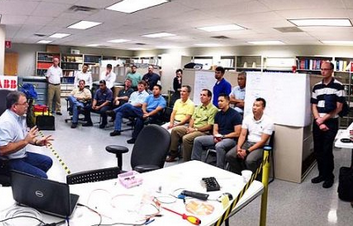Insights > Leaner, Faster, Cheaper: Is Fiber the Answer?
Leaner, Faster, Cheaper: Is Fiber the Answer?
02/11/2015

What if there were a substation alternative to copper that was faster, cheaper and less likely to be stolen? A team at Entergy thinks fiber optic cable might be the answer.
For the past several months, a team of Entergy's transmission engineers has been evaluating the use of fiber in the company's substations. (Their work is an assessment of the International Electrotechnical Commission's 61850 industry standard.)
"Our team has been working closely with other U.S. utilities, research institutes, vendors and consultants to study the possibilities of enhancing our substations by replacing most copper wires with fiber optic cable," said Dr. Chan Wong, a senior engineer working in Kenner, La. "This technology is already being used in Europe, and a small number of American utilities are beginning to adopt it."
This use of fiber has been tested extensively in the lab, with excellent results. Next year, Entergy will begin a field pilot at the Joliet substation near New Orleans, La., installing several test panels and then monitoring and tracking their performance.
The research group participated in a hands-on demonstration testing the new feeder protection scheme via IEC 61850 at Entergy's lab in Kenner, La.
Proponents of fiber claim a persuasive list of benefits:
- Fiber is leaner. Substations using fiber instead of copper need less cable overall. That leads to less risk exposure and neater facilities.
- Fiber is faster. After a severe weather event, it's quicker to restore fiber. Instead of relying heavily on copper wires looped throughout a substation, a few buried fiber channels serve the same purpose. Not only are those buried channels more hardened against weather, they are more easily restored after a weather event.
- Fiber is cheaper. In comparison to copper, fiber offers significant savings. Analysis projects fiber can be designed and installed for about half the cost of copper wires.
- Fiber is less likely to be stolen. In recent years, utilities throughout the country have experienced significant copper theft problems. The resale value of fiber-optic cable is lower than copper. In addition, more of it's buried, making it harder for thieves to access.
If Entergy could realize these advantages in its substations, it would lead to sustainable value for customers and owners through increased reliability and cost savings. Neater substations and less complicated storm restorations would also offer safety benefits to employees.
Entergy isn't alone in investigating the benefits of fiber. The Electric Power Research Institute is an independent nonprofit dedicated to research and development related to the generation and delivery of electricity. The organization has worked closely with Entergy's team and others from throughout the industry to craft a global design standard for using fiber technology.
"The installation of fiber in America's substations would advance substation automation and communication for all utilities," added Wong. "In addition, it would help us achieve interoperability and compatibility between different manufacturers' equipment. Think of it as an Ethernet network for substations, one that connects multiple systems and has encrypted protocols to control the passage of information. It just makes the grid that much smarter and leaner.
"We're excited to see where this new technology can take us," Wong said, "and we've really enjoyed the collaborative effort with our Entergy transmission groups, the industry and EPRI that has gotten us this far."
